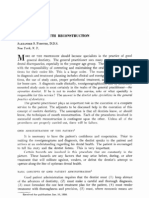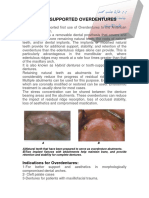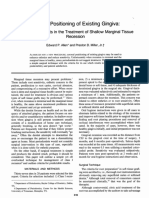Extractions 1
Extractions 1
Uploaded by
api-114759194Copyright:
Available Formats
Extractions 1
Extractions 1
Uploaded by
api-114759194Original Title
Copyright
Available Formats
Share this document
Did you find this document useful?
Is this content inappropriate?
Copyright:
Available Formats
Extractions 1
Extractions 1
Uploaded by
api-114759194Copyright:
Available Formats
SURGICAL EXTRACTIONS: INDICATIONS AND EQUIPMENT
By Tony M. Woodward, DVM, AVDC We continue describing the five basic dental services that all general practitioners should be able to provide for their patients. Previously we covered dental radiology. This article will discuss the rationale and equipment used for surgical extractions. Historically, dental extractions have been viewed as necessary mainly when excessive tooth mobility is observed. Teeth exhibiting a high grade of mobility are easily extracted using dental elevators and forceps, in some cases falling out as soon as calculus is removed. For many general practitioners, if a tooth does not show mobility, it is left in regardless of what pathology is present. Because extractions on highly mobile teeth are easily accomplished, they have frequently been left to the veterinary technicians to perform. This attitude can lead to undercharging or not charging for extractions (it only took the technician a few minutes) and client expectations that extractions are free and are included with a dental cleaning procedure. It should be noted that extractions are considered a surgical procedure, and as such are illegal for technicians to perform in most states. This creates a legal liability for the supervising veterinarian who directs their technicians to perform this procedure. Surgical extractions involve the elevation of gingival flaps to provide adequate exposure, sectioning of multi-rooted teeth, cortical bone removal using a high-speed drill, luxation of the tooth segments with dental elevators, smoothing of the alveolar bone, and closure of the extraction site using muco-gingival flaps. When a clinician begins to aggressively look for and treat dental disease, they quickly realize that most needed extractions are on teeth with no mobility, and are best accomplished using a surgical technique. Surgical extraction techniques serve to improve exposure, increase patient comfort due to refinement in technique, decrease the incidence of complications such as root end fracture, and speed post-operative healing. For the above reasons, the author prefers to perform almost all extractions using a surgical technique. Some clinicians have preferred to leave extraction sites open, stating the need to allow drainage. Drainage is simply not required. In humans, extraction sites are not routinely closed. This is due to cosmetic considerations and the fact that human patient can be relied upon to keep extraction sites clean. The indications for dental extractions include a wide variety of pathological conditions. A brief list is included below. This list should be tempered with the knowledge that many of these conditions can be treated. Whether to treat or extract a tooth depends on many factors. Some clients prefer to maintain all dentition if the prognosis is reasonably good for success. Certainly, the option of treatment vs. extraction should be offered when applicable, if only for liability reasons. Some teeth are more important for function such as the carnassial teeth (upper fourth premolar and lower first molars), and as such deserve consideration for treatment rather than extraction. Extraction of some teeth involves a large amount of bone removal, which can be painful and damage or weaken surrounding structures. An example would be a fractured mandible which occurred secondary to extraction of a lower canine tooth. For reasons previously stated, clients often think of an extraction as a cheap, fast treatment option for diseased dentition. Frequently, extraction of a diseased tooth is more painful, takes longer, and decreases function
more than treatment of that same tooth. Teeth that particularly deserve treatment consideration include the canine teeth and the carnassial teeth. In certain breeds, all of the anterior dentition can be important to show success. The astute clinician presents all options for treatment, along with the pros and cons of each option. Let the client decide which option they prefer. A frequently misunderstood area of veterinary dentistry involves feline extractions. I have heard many people state that when extracting teeth in feline patients, one has to simply amputate the crowns, leaving the roots to magically reabsorb. This is a barbaric practice. How would you feel if your dentist amputated your crown, leaving an exposed amputated root fragment and nerve tissue. Would you feel better knowing that in a few years the root would be reabsorbed and the area healed over? Many of my feline patients have chronic draining tracts with root fragments left under the gum line. After treatment, owners notice these patients acting much better. This misunderstanding dates back to a 1995 article on intentional root retention. This article stated that this technique can be used if: 1. 2. 3. 4. 5. 6. There is radiographic evidence of bony replacement resorption. There is no evidence of endodontic disease. There is no evidence or periodontal disease There is no ulcero-proliferative disease (Stomatitis) The dental tissues are amputated 2-3 mm below the level of the alveolar bone. The extraction site is sutured closed.
Unfortunately, many people forget the six caveats stated above, and simply choose to remember that in cats, you only need to amputate the crowns. It is always safer and better for the patient to remove all remnants of the tooth when performing extractions.
Some common indications for dental extractions
*Fractured teeth with pulp exposure *Non-vital teeth Complete furcation exposure (Grade III) Periodontal disease with loss of >50% bone *Periodontal Disease with secondary endodontic disease *Mobility >1mm Retained deciduous teeth Interceptive Orthodontics * These conditions can often be treated rather than simply extracting the teeth Supernumerary teeth, if causing problem Dentigerous Cyst *Malpositioned teeth causing trauma Resorptive lesions, in most cases Retained roots if associated with inflammation or drainage Cases that client is unwilling to treat.
Dentalaire Products 800.866.6881
Dental Instrumentation Like all other surgical techniques, having the proper equipment makes the procedure go more smoothly and facilitates a more professional result. The following list includes the instruments and materials that the author finds useful for surgical extractions. 1. High-speed delivery unit with integrated water coolant 2. Burs for high-speed handpiece: 1/2, 1. 2, 4, 700, 701,701L, cylindrical diamond, conical white stone 3. Scalpel blades: #11, #15, #15C 4. Periosteal elevators: Molt #2, Molt #4, and Freer 5. Dental elevators: Winged Elevators #1-4; Luxators in various sizes 6. Extraction forceps: Small rongeurs work well 7. Small Alveolar Curette 8. Tissue Forceps: Brown-Adson 7X7 tooth 9. Olsen-Hegar Needle holders, 5 1/2 inch 10. Scissors: Dean 11. Excellent lighting 12. Dental Radiographs (mandatory) 13. Gel-foam for hemostasis 14. Consil synthetic allograft for bone augmentation 15. Suture: Dexon, Vicryl, Monocryl, or Chromic Gut in 3-0 to 5-0 sizes, with reverse cutting or tapered needle. My personal preference is to use 5-0 Dexon for almost all extractions. 16. Root tip picks for retrieval of fractured root tips Many of these specific extraction instruments are carried in the Woodward Extraction Kit produced by Dentalaire. I can perform 98% of all my extraction work utilizing this instrument set. There are several good dental delivery units available on the market. I own six of the Dentalaire units which we use to teach classes. These have proven to be very dependable units under a hard work load. I recommend that you look at Dentalaires Ultimate unit, which includes a high quality piezoelectric scaler and fiber-optic lighting built into the high speed handpiece. The combination low speed motors/scaler units are very adequate for cleaning procedures, but function poorly for extractions. The low speed micro-motor handpieces only turn at a maximum speed of 35-40,000 rpm, compared to 400,000 rpm for a compressor driven high speed handpiece. The micro-motor handpieces lack an integrated water coolant, and frequently burn bone and bog down as the operator attempts to section teeth and remove bone. If you have suffered through extractions using a micro-motor, you will be pleasantly surprised at how much easier procedure go with a high-speed unit.
Dentalaire Products 800.866.6881
You might also like
- Complications of ExodontiaDocument33 pagesComplications of ExodontiaSunil Tiwari100% (1)
- Acrylic Partial DenturesDocument5 pagesAcrylic Partial DenturesCloudcynaraaNo ratings yet
- 1 Introduction and Ideal OcclusionDocument33 pages1 Introduction and Ideal OcclusionJASPREETKAUR0410100% (1)
- Chapter 21: Extraction: Who Should Be Extracting Teeth?Document12 pagesChapter 21: Extraction: Who Should Be Extracting Teeth?minaxi123No ratings yet
- 2 ExodontiaDocument53 pages2 ExodontiaWasiAliMemonNo ratings yet
- Endodontic Surgery: EndodonticsDocument28 pagesEndodontic Surgery: Endodontics13eee100% (1)
- Endodontic SurgeryDocument21 pagesEndodontic SurgeryFusea RaduNo ratings yet
- Pediatric Exodontia: Chapter OutlineDocument17 pagesPediatric Exodontia: Chapter OutlineFazlur EhmNo ratings yet
- Isolite - Isolation and Digital - Ricci PDFDocument4 pagesIsolite - Isolation and Digital - Ricci PDFDentalLearningNo ratings yet
- Crown LengtheningDocument4 pagesCrown LengtheningArdelvie YoandaNo ratings yet
- Tugas Ikga Text BookDocument7 pagesTugas Ikga Text BookAprilTerbaeekNo ratings yet
- Tooth AutotransplantationDocument5 pagesTooth AutotransplantationTatiana MunteanuNo ratings yet
- Esthetic Considerations With Removable Partial DenturesDocument11 pagesEsthetic Considerations With Removable Partial Denturesapi-3710948100% (2)
- Lecture 13 - Extraction of ToothDocument46 pagesLecture 13 - Extraction of Toothvanesa AvramovaNo ratings yet
- Seminar 6 Preventive Prosthodontics in CD WordDocument29 pagesSeminar 6 Preventive Prosthodontics in CD Wordketaki kunteNo ratings yet
- Group Vi: Clinical Furnishings and FormsDocument18 pagesGroup Vi: Clinical Furnishings and FormsJasmine Rey QuintoNo ratings yet
- Seminar 6 Preventive Prosthodontics in CD WordDocument29 pagesSeminar 6 Preventive Prosthodontics in CD Wordketaki kunteNo ratings yet
- Adjuncts To Mouth Reconstruction S.: Alexander Forster, New York, N. YDocument5 pagesAdjuncts To Mouth Reconstruction S.: Alexander Forster, New York, N. YAmar BhochhibhoyaNo ratings yet
- Ce 420Document24 pagesCe 420Tupicica GabrielNo ratings yet
- Sduggan'S Ebook: Dental Implants CostDocument7 pagesSduggan'S Ebook: Dental Implants Costsduggan9No ratings yet
- Endo Instruments and MaterialsDocument131 pagesEndo Instruments and MaterialsIndrani DasNo ratings yet
- Implantology I. Read The Article and Answer The Following Questions On Dental ImplantsDocument4 pagesImplantology I. Read The Article and Answer The Following Questions On Dental ImplantsralucaNo ratings yet
- Piezotome Cube OverviewDocument3 pagesPiezotome Cube OverviewWisam Al-RawiNo ratings yet
- Dental Implant DissertationDocument6 pagesDental Implant DissertationHelpMeWriteAPaperUK100% (1)
- nhs-quandoper-titeDocument2 pagesnhs-quandoper-titeIsabel Michelucci BrancoNo ratings yet
- ToothsavingtipsDocument2 pagesToothsavingtipsSicheng LuNo ratings yet
- Endodontist or Dentist - Which Makes The Right Choice?Document2 pagesEndodontist or Dentist - Which Makes The Right Choice?Tarun KumarNo ratings yet
- The Case Against The Use of Dental Implants in Dogs and CatsDocument6 pagesThe Case Against The Use of Dental Implants in Dogs and CatsWilliam ChandlerNo ratings yet
- Prosthodontics Lec#3Document12 pagesProsthodontics Lec#3Forat hussienNo ratings yet
- We Are Intechopen, The World'S Leading Publisher of Open Access Books Built by Scientists, For ScientistsDocument14 pagesWe Are Intechopen, The World'S Leading Publisher of Open Access Books Built by Scientists, For ScientistsMostafa El GendyNo ratings yet
- Anaesthesia Free Dental Procedures 2013Document2 pagesAnaesthesia Free Dental Procedures 2013brunoartsanddesignNo ratings yet
- Extraction of A Maxillary Molar Tooth-Simplified (A Case Report)Document5 pagesExtraction of A Maxillary Molar Tooth-Simplified (A Case Report)Farizah Aryanti JooNo ratings yet
- Patienten Information EndoDocument7 pagesPatienten Information EndoJuan PelaezNo ratings yet
- Post Insertion Complaints of Removable Dental Prostheses: October 2018Document5 pagesPost Insertion Complaints of Removable Dental Prostheses: October 2018Javaria IftekharNo ratings yet
- Extraction: Department of Oral and Maxillofacial SurgeryDocument26 pagesExtraction: Department of Oral and Maxillofacial SurgerySudip ChakrabortyNo ratings yet
- Extraction of TeethDocument84 pagesExtraction of TeethAkram Thabet50% (2)
- TREATMENT PROTOCOLS with alignersDocument4 pagesTREATMENT PROTOCOLS with alignersdrvrundashah2007No ratings yet
- Domfs Preclinic III enDocument18 pagesDomfs Preclinic III enMariya NazimNo ratings yet
- Ormcocatalog 7mbDocument166 pagesOrmcocatalog 7mbDeep GargNo ratings yet
- Thesis Dental ImplantsDocument4 pagesThesis Dental Implantstmexyhikd100% (2)
- Tooth Autotransplantation. What's The Limit of Our Possibilities in Conservative Treatments?Document6 pagesTooth Autotransplantation. What's The Limit of Our Possibilities in Conservative Treatments?Danis Diba Sabatillah YaminNo ratings yet
- Over DentureDocument19 pagesOver DentureAmmar Pasha SiddiquiNo ratings yet
- Maintaining Good Oral HygieneDocument10 pagesMaintaining Good Oral Hygieneسالم اعويداتNo ratings yet
- Extractions in OrthodonticsDocument6 pagesExtractions in OrthodonticsZubair AhmedNo ratings yet
- Dental SurgeryDocument3 pagesDental SurgeryMCK1348No ratings yet
- Immediate DenturesDocument35 pagesImmediate DenturesPrince AhmedNo ratings yet
- Galler Spacing Technique (GST) ManualDocument44 pagesGaller Spacing Technique (GST) ManualDavid Galler100% (1)
- Pre-Implant - Prosthodontics 2Document56 pagesPre-Implant - Prosthodontics 2Ameera RabayahNo ratings yet
- Department of Oral & Maxillofacial Surgery: Rungta College of Dental Sciences & Research Kohka, BhilaiDocument201 pagesDepartment of Oral & Maxillofacial Surgery: Rungta College of Dental Sciences & Research Kohka, BhilaiIrfan Ali100% (1)
- Patient Care Letter & Consent Form DateDocument10 pagesPatient Care Letter & Consent Form DaterchmurovicNo ratings yet
- Modern Trends in The Development of DentistryDocument38 pagesModern Trends in The Development of DentistryAhmed DsoukiNo ratings yet
- J Am Dent Assoc 2005 Christensen 1711 3Document3 pagesJ Am Dent Assoc 2005 Christensen 1711 3Gina CastilloNo ratings yet
- Serial ExtractionDocument38 pagesSerial ExtractionRamy HanyNo ratings yet
- Colleagues For Excellence: Its Role in Retaining Our Patients' Natural DentitionDocument8 pagesColleagues For Excellence: Its Role in Retaining Our Patients' Natural DentitionJessica AnggonoNo ratings yet
- Tooth-Supported Overdentures 2 PDFDocument7 pagesTooth-Supported Overdentures 2 PDFKrupali JainNo ratings yet
- Single-Visit Endodontics: A ReviewDocument6 pagesSingle-Visit Endodontics: A ReviewPrawira SetiadarmaNo ratings yet
- Advances in Orthodontic TreatmentDocument12 pagesAdvances in Orthodontic Treatmentpopat7850% (2)
- Oral Implantology: ImplantsDocument52 pagesOral Implantology: ImplantsDabala Harish Reddy100% (6)
- Removable Appliance 2Document5 pagesRemovable Appliance 2RobertNo ratings yet
- Esthetic Oral Rehabilitation with Veneers: A Guide to Treatment Preparation and Clinical ConceptsFrom EverandEsthetic Oral Rehabilitation with Veneers: A Guide to Treatment Preparation and Clinical ConceptsRichard D. TrushkowskyNo ratings yet
- Pulpal and Periapical PathologyDocument101 pagesPulpal and Periapical Pathologyammara100% (1)
- Dental Fee Guide General 2013Document94 pagesDental Fee Guide General 2013cititoruleleNo ratings yet
- Needle Point Tracing Centric RelationDocument12 pagesNeedle Point Tracing Centric RelationAmar BhochhibhoyaNo ratings yet
- Dental Assisting CoursesDocument8 pagesDental Assisting Coursessongyifei0903No ratings yet
- Positioning Existing: GingivaDocument4 pagesPositioning Existing: GingivaAna Maria Montoya GomezNo ratings yet
- EassyDocument10 pagesEassySher Baz nighaNo ratings yet
- Esthetic in Pediatric DentistryDocument13 pagesEsthetic in Pediatric DentistryAtikahNo ratings yet
- Hayrax Con Mascara Facial PDFDocument8 pagesHayrax Con Mascara Facial PDFSantos LopNo ratings yet
- Class III, IV, V Direct CompositeDocument94 pagesClass III, IV, V Direct Compositemarukala100% (1)
- Clinical Case ConferenceDocument22 pagesClinical Case ConferenceTallal BurwagNo ratings yet
- Oral Pathology Reporting Flow: ScriptDocument2 pagesOral Pathology Reporting Flow: ScriptMikee MorsiquilloNo ratings yet
- 1 PDFDocument2 pages1 PDFAdelina RuncanNo ratings yet
- Beak and Bumper - Physics Forceps: Evaluation of New Technique in ExtractionDocument10 pagesBeak and Bumper - Physics Forceps: Evaluation of New Technique in ExtractionWuppuluri Jayanth Kumar SharmaNo ratings yet
- Prosthodontic Management of Compromised Ridges and SituationsDocument8 pagesProsthodontic Management of Compromised Ridges and Situationskhalisha salsabila100% (2)
- A Scientist's ScientistDocument56 pagesA Scientist's Scientistapi-26032005No ratings yet
- SIM Card Masterlist Wo Employee NumberDocument116 pagesSIM Card Masterlist Wo Employee NumberJuan LorenzoNo ratings yet
- Comparison Between Phosphoric Acid and Hydrochloric Acid in Microabrasion Technique For The Treatment of Dental UorosisDocument5 pagesComparison Between Phosphoric Acid and Hydrochloric Acid in Microabrasion Technique For The Treatment of Dental UorosisCeida Lopez CastillaNo ratings yet
- Expodent Chennai 2024 Trade BrochureDocument8 pagesExpodent Chennai 2024 Trade BrochureKavi Mukilan KamarajNo ratings yet
- Jurnal Utama ProstoDocument5 pagesJurnal Utama ProstoParlin BrutuNo ratings yet
- Syria Portfolio (En)Document14 pagesSyria Portfolio (En)orhunyukNo ratings yet
- Challenges of Restoring An Anterior Maxillary Tooth, The Impact of Fluorescence and Mock-Up Approach. Quintessence InternationalDocument5 pagesChallenges of Restoring An Anterior Maxillary Tooth, The Impact of Fluorescence and Mock-Up Approach. Quintessence InternationalGiovanni LemeNo ratings yet
- The Infertility Dentistry ConnectionDocument4 pagesThe Infertility Dentistry ConnectionDavidNo ratings yet
- Chemical Plaque Control Strategies in The Prevention of Biofilm-Associated Oral DiseasesDocument8 pagesChemical Plaque Control Strategies in The Prevention of Biofilm-Associated Oral DiseasesAlex KwokNo ratings yet
- Medi MeetDocument3 pagesMedi MeetCzarina Mae BautistaNo ratings yet
- 14 PDFDocument1,474 pages14 PDFAiluul Almaa100% (5)
- 1-Enamel AnswersDocument15 pages1-Enamel AnswersOla AliNo ratings yet
- Course Challenge - CourseraDocument1 pageCourse Challenge - CourserahajjeaopaNo ratings yet
























































































